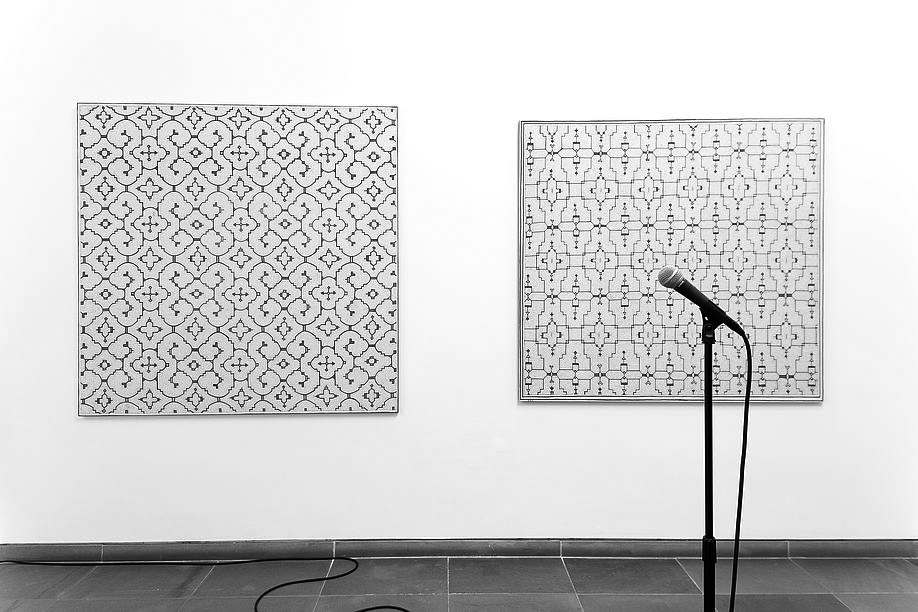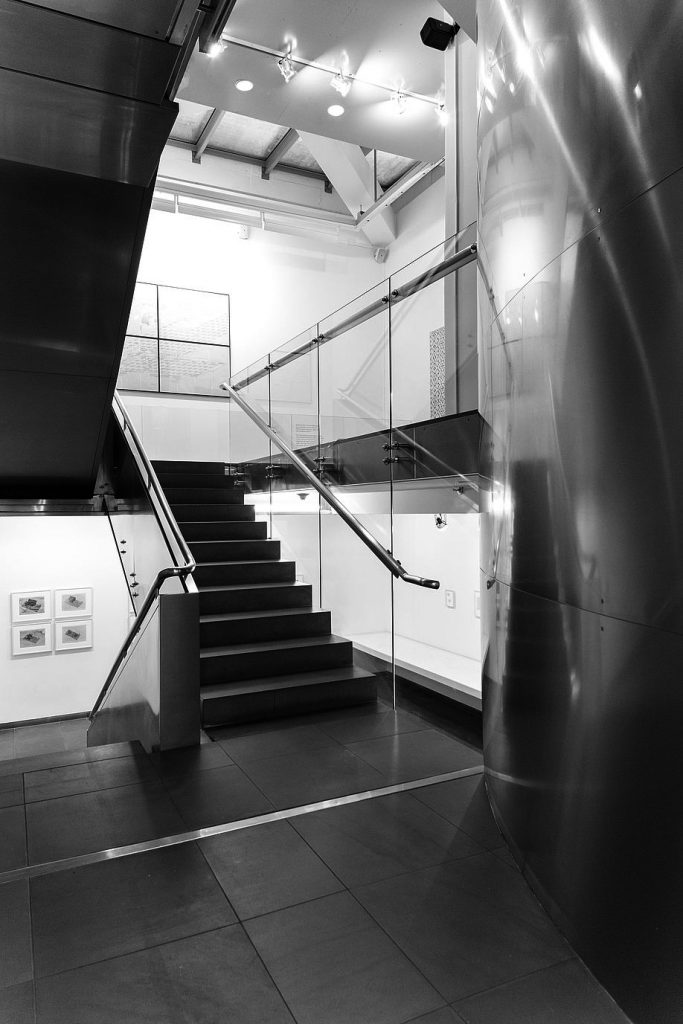Sara Flores and the Shipibo
Conibo Center: How to Curate
Work by Indigenous Artists
within International Exhibitions
of Contemporary Art
The Projective Drawing
Austrian Cultural Forum, New York
06.02.18 – 13.05.18
Inclusion of art by indigenous artists within conventional, thematic exhibitions and biennials of international contemporary art has a relatively short history. For centuries there has existed a division between institutions of art and those of anthropology, in which the cultural production of members of indigenous communities were relegated to the latter, and with few exceptions there was little opportunity to view indigenous art as art – meaning, within the context of art museums and galleries – and there were few opportunities for cross-cultural comparisons. The inclusion of paintings by Doreen Reid Nakamarra and work by Sámi Artist Group ( Keviselie / Hans Ragnar Mathisen, Britta Marakatt-Labba, Synnøve Persen ) in Documenta 14, and Inuit artists such as Kananginak Pootoogook in the most recent Venice Biennale, are just some examples from the past decade of a marked shift, in both perspective and practice, within contemporary curating. The Projective Drawing at the Austrian Cultural Forum in New York City is a recent contemporary art exhibition, which included work by an indigenous artist. This review positions the exhibition as a case study within this short history, and examines the progress and pitfalls of curating work by indigenous artists within international contemporary art exhibitions.
The Projective Drawing was an exhibition of contemporary drawing curated by the Drawing Center’s director, Brett Littman. It featured work by international artists whose sensorial qualities required an alternative framework of interpretation to conventional methods centred on visual perception and disinterested aesthetic appreciation. Through drawings by artists such as Katrin Sigurdardóttir and William Cordova, the exhibition probed how to conceive of an understanding that accommodates all sensations that influence one’s perception and experience of drawing – a practice that can be traced back to prehistory, and across all cultural divides.
The exhibition adapted its title and premise from The Projective Cast ( 1995 ), a book by the historian Robin Evans, which posed the same question about architecture. In The Projective Drawing, the curatorial premise explored how to accommodate approaches to drawing ( and art-making in general ) that are not typically represented in museum spaces – practices that reference cultures and traditions with aesthetic qualities and gestures, but that, for understanding, require a concerted shift in ideological and perceptive frameworks. That question of how to present drawing that comes out of spiritual practice, in a way that accounts for, and makes visible, its status as part of a ritual rather than an aesthetic object produced in the Western tradition, was especially pertinent to the exhibition’s central installation: three drawings by Sara Flores, the only indigenous artist included in the presentation, which was installed with an immersive sound installation by the Shipibo Conibo Center.
Flores was born in 1950, in the indigenous community of Tambomato, in the Loreto region of the Peruvian Amazon. At the age of fourteen she began an apprenticeship with her mother, who taught her how to produce pigments from natural flora, and how to create forms, freehand, that related to the icaro, or spiritual magic, which accompanied various shamanic rituals of the rainforest. Flores developed a style of hypnotic, pattern-like drawing, which she used to produce even, overall compositions, interpreted from music and sounds of the rainforest. Flores met the researchers and artists who started the Shipibo Conibo Center in New York, while they were conducting academic and artistic fieldwork in Peru; they began to collaborate on developing ways of presenting Flores’s work, for exhibition to audiences in the United States.
For The Projective Drawing, the Shipibo Conibo Center stretched three of Flores’s drawings on raw canvas onto wooden stretchers, and hung them together on two perpendicular walls, in classic museological fashion. They created a responsive sound component for the installation, using their field recordings of the rainforest. Inside the installation, they placed a microphone and installed two speakers above the drawings. A wall text next to the two-wall installation encouraged visitors to speak into it, to elicit a ‘response’ from the rainforest and thus conjure up an image of the context to which Flores’s work referred.
How Flores’s drawing related to ceremony, whether or not there was a historic significance to the patterns, and whether there was any significance in the repetition of the patterns and the experience of hallucinogens, were all questions to which the exhibition did not provide any information or answers. There was only a wall text, encouraging visitors to say ‘ohm’ into the central microphone, which conjured up a stereotypical, and generic, image of a non-Western ceremony. These kinds of details positioned Flores’s drawings – the only works created outside the framework of Western traditions – as the work of an exceptional Other.
This responsive sound component turned Flores’s presentation of drawing into an immersive, multimedia installation, which staged a recreation of but one element of the ceremonial experience. For one thing, the sonic translation into stereo speakers of the entire sound world of a chorus of forest creatures literally flattened everything out and gave visitors a false understanding of what would certainly have been a highly sensory experience, involving humidity, hallucinogens and a historically-rooted practice of healing. There was no mention, for instance, of what the shamanic ceremonies that related to Flores’s patterns were for, or how ‘healing’ was understood in Shipibo culture. Nor was it clear whether the act of making the drawings was done as part of a ceremony, or whether the finished drawings played a role within the ceremony, or both. The call and response element of the work turned the installation into something of a game, to create a reaction, yet that reaction didn’t seem to have any generative function beyond illustrating the point in the wall text – that the works were to be understood as sharing a kinship with a natural habitat.
Such lack of precision is common when artists of indigenous identification are presented in Western institutions, but it leaves viewers to fall back on preconceived ideas and images: just pictures, drugs, forest, animals and a woman making drawings – most of them, images that would have been familiar to people from Hollywood movies or the National Geographic Magazine. Precision and specificity are the only elements that might be capable of recuperating work such as Flores’s from the assimilating function of the white cube.
When thinking about how to present contemporary indigenous art in museums, a good comparison and historical precedent is the case of aboriginal contemporary art in Australia. That there is a large market for abstract aboriginal painting and a willingness to include this work in major contemporary art biennials may be traced back to the work of the art teacher Geoffrey Bardon, who worked with aboriginal Papunya peoples in a government settlement in the early 1970s. He provided Western materials ( construction paper, tempera paint, etc. ) and was amazed at what the Papunya men created from these. They reproduced patterns related to ceremony, in which art-making had a spiritual utility, and transposed them to murals and drawings, related to their tradition but largely divorced from their function. The transposition of one format to another ( e.g. a mark on a tree bark vs. the same mark on paper – or even removing the actual bark from the tree to display it in the same fashion as a traditional Western drawing ) was a tacit metaphor for the violence inherent in the process of assimilation.
Everywhen, an exhibition held at the Harvard Art Museums in 2016, which was based on aboriginal conceptions of time, showed an eternal present that could not be separated from past or future: the curators placed contemporary aboriginal drawings next to traditional ceremonial objects, but didn’t account for the translation of ceremonial drawing to contemporary art drawing. How to do that in space is a difficult question; it might be useful to offer a comparison between historic use and present use, instead of making comparisons between the drawing’s historic use and present status, as art objects. The latter procedure gives the false impression that ritual objects are a product of the past, and contemporary drawings a product of the present.
Flores’s inclusion within an exhibition of contemporary art is a productive step in the long history of showing indigenous art in Western museums, which, until recently, relegated the work of indigenous peoples to the status of ahistoric and anonymous, functional objects for anthropological study. Although there has been much effort in art museums in North America over the past ten to fifteen years to exhibit work by indigenous artists, exhibitions such as The Projective Drawing mark a more recent shift to considering contemporary indigenous art next to work by Western contemporary artists – and should be celebrated for this. Yet within this productive development, curatorial practice has yet to work out how to make visible the differences between cultures in ways that do not ‘other’ the indigenous artist, but rather how to present artists within Western institutions on an equal basis – one that would recuperate and remind people within a global, neo-liberal society of the infinite ways that human beings have lived and continue to live, and conceive of time, art, healing and other cultural practices that are being rapidly foreclosed as a result of deforestation, climate change and the expansion of neo-liberal economic policies.
萨拉·弗洛雷斯与纽约西皮波·科尼宝中心: 如何在国际当代艺术展上策展由土著艺术家创作的作品
投射式绘画
奥地利文化论坛, 纽约
2018 年2 月6 日—5 月13 日
译 / 顾虔凡
在当代艺术传统的专题展和国际双年展中囊括土著艺术家的作品,这类策展实践的历史很短。数个世纪以来,艺术与人类学之间泾渭分明,除了少数例外,大部分土著社群的文化产物都被降格为后者。就艺术博物馆和画廊的语境而言,土著艺术鲜少有机会能被正视为艺术,也极少能进行跨文化的对比。在第13 届文献展上,Doreen Reid Nakamarra 的绘画作品、( 由Keviselie / Hans Ragnar Mathisen, Britta Marakatt- Labba, Synnøve Persen 组成的) 艺术群体 Sámi Artist Group 的创作得到了呈现;此外,最近一次威尼斯双年展也展出了诸如Kananginak Pootoogook 等因纽特艺术家的作品。这些都是过去十年间的一些个例,它们反映出当代艺术策展中观点与实践的转变。纽约城中奥地利文化论坛最近举办的展览“投射式绘画” 也包括了一位土著艺术家的作品。这篇展评将视其为土著艺术家参展之短暂历史中的一则案例分析,以此检视在国际性的当代艺术展览中策展土著艺术家作品的进展与困难。
纽约奥地利文化论坛的展览“投射式绘画”由绘画中心的总监布莱特·利特曼策展。展览作品的创作者们所具有的感性特质, 需要一种替代性的阐释框架来予以理解,而非那些以视觉感知及美学欣赏为核心的传统方法。展览通过卡特琳·西于尔扎多蒂及威廉·科尔多瓦等艺术家的绘画作品,探讨了如何构想一种理解, 去容纳所有影响人们感知并体验绘画的感受,这种实践方式可以追溯至史前历史并跨越所有的文化鸿沟。

Sara Flores, Untitled, undated, vegetal dyes on canvas, dimensions variable, sound installation by the ShipiboConibo Center. Courtesy the artist. Photo © Luca Mercedes. 萨拉·弗洛雷斯( Sara Flores ),《无题》,未标注日期,植物染料于油画布面,尺寸可变,声音装置由纽约西皮波·科尼宝中心( Shipibo Conibo Center )制作。图片致谢艺术家,摄影 © 卢卡·梅赛德斯( Luca Mercedes )。
展览标题来自历史学家罗宾·埃文斯1995 年出版的书《投射式铸造》,这本书针对建筑提出了类似的疑问。在“投射式绘画”中,策展人探讨的前提是,在博物馆空间中,不太具有代表性的实践方式如何能够纳入到绘画(以及更为普遍的艺术创作) 之中——这些实践将文化、传统与美学特质、姿态进行互相参照, 但它们需要在意识形态及感知框架上进行转变以得到更好的理解。来自于精神实践的绘画,通常会作为仪式的一部分,而且能够使仪式得以显见,这与西方传统中身为审美产物的绘画很不同,而如何呈现这些充满灵性的绘画这一问题与展览中的核心装置作品密切相关:三件由萨拉·弗洛雷斯创作的绘画,她是展览中唯一一位来自土著社群的艺术家,而整件装置作品还包括了来自西皮波·科尼宝中心创作的沉浸式声音装置。

The Projective Drawing, installation view, Austrian Cultural Forum, New York, 2018. Courtesy Austrian Cultural Forum. Photo © Luca Mercedes. “投射式绘画”( The Projective Drawing )展览现场,纽约奥地利文化论坛,2018年。图片致谢奥地利文化论坛,摄影 ©卢卡·梅赛德斯( Luca Mercedes )。
弗洛雷斯1950 年出生于秘鲁亚马逊洛雷托的土著社区坦博梅约。14 岁开始,她跟随母亲学习如何从花卉草木中提取颜料, 以及如何徒手绘制形体,这些都与名为“伊卡罗的精神魔法有关, 是各种雨林萨满仪式的一部分。弗洛雷斯逐渐发展出一种有如催眠般魔力的样式绘画风格,用以制作平整的构图,它们与雨林中的音乐及声响相关。纽约科尼宝中心的研究人员们在前往秘鲁进行有关学术及艺术的田野调查时认识了弗洛雷斯;双方开始展开合作,共同寻找恰当的方式向美国的观众展出弗洛雷斯的作品。
在“投射式绘画”展览中,科尼宝中心将弗洛雷斯的三幅画布铺展到木质框架上,并以经典的博物馆风格将其悬挂在两堵垂直的墙面上。他们用雨林田野调查的录音,为这件装置创作响应式的声音部件。他们在绘画装置的内部放置了一个麦克风,又放了两个扬声器在画作上方。两堵墙面装置一侧的展墙文字鼓励观众对着装置说话,以产生来自雨林的“回应”,从而召唤出弗洛雷斯作品所指涉的那种图像语境。
弗洛雷斯的绘画与仪式的关联并没有在展览中得到充分的解释,无论是其中的图案是否具有历史意义,还是图案的重复及致幻的体验是否重要。整件装置作品只有一张展签,就是鼓励观看者对着中间的麦克风发出“ohm”的哼鸣声——它所展现的正是有关非西方仪式的一种刻板印象。作为展览中唯一一件在西方传统框架之外进行创作的作品,上述的细节将弗洛雷斯的画作定位成一种非常特殊的他者般的存在。
响应式的声音部件将弗洛雷斯的绘画转变成一种沉浸式、多媒体的综合装置,它设置出了一种仪式性的体验,但仅仅提供了这种体验中的一个元素。首先,将雨林环境里各种生物环绕齐鸣的声音转译为立体声扬声器的播放,这大大地压缩了声音环境的丰富性,也为这种集空气中的湿气、致幻剂以及历史悠久的疗愈实践为一体的高度感性的体验提供了一种错误的理解。举例来说, 弗洛雷斯创作中的图案与萨满仪式的关联,或者如何理解希皮博人的疗愈仪式,这些都没有得到只字片语的介绍。观众也并不清楚到底是绘画的制作过程,还是最终完成的绘画会被算作传统仪式的一部分。装置中声音部分的呼喊及回应,让作品更像是一个游戏,从而创造出一些反应,但是这种反应似乎没有产生太多效果,透过展签文字,我们只知道对于这件作品的理解必须与自然的栖息地密切相关。
在西方的机构中展示土著艺术家的作品,经常像这样缺少确切的介绍,但是这也让观众不至于完全仰仗那些先入为主的想法和图像:药物、森林、动物,还有一个作画的女人——大部分诸 如此类的图像都会让人想起好莱坞电影或是《国家地理》的画面。弗洛雷斯的作品在白盒子的空间中会产生彼此同化的效果,而确切具体的介绍,是唯一能够进行调整的方式。
在思考如何在博物馆中呈现当代土著艺术的问题时,有一个很值得参考的前例是澳大利亚的土著当代艺术。抽象风格的土著绘画在那里有着成熟的市场,并且这类作品常被囊括到重要的当代艺术双年展中,这可以追溯到20 世纪70 年代早期,一位叫乔福瑞·巴尔登的艺术老师与受到政府安置的帕潘亚原住民进行了许多创作方面的合作。当时,巴尔登为原住民提供了许多西方的材料(像是建筑图纸、蛋彩画等),并且惊叹于他们的创作。在土著传统仪式中,艺术创作具有一种精神性的效用,原住民重新创作了这些与土著仪式密切关联的图案,并将其转化成壁画、油画的形式,保留与传统的联系,同时在很大程度上使其脱离原始含义。将一种形式转化成另一种形式(例如,在树皮上做标记vs. 在纸上做出相同的标记——或者,甚至是将那截树皮从树上剥离后用传统西方绘画的方式呈现),是在默默地隐喻同化过程中固有的暴力。
最近在哈佛艺术博物馆举办的展览“时常”(2016 年), 关注了土著文化中的时间概念:一种无法与过去和未来脱节的永恒的当下。在展览中,策展人将当代土著绘画与传统仪式中使用的物件并置在一起,但是并没能充分说明仪式性绘画向当代绘画的转译。如何在空间呈现中做到这一点确实十分困难,也许一个比较好的方式是在绘画的历史性用途与当下用途之间进行比对, 而不是在其历史性用途与作为艺术品的当代状态之间进行比对。因为后者带给人的错觉是,仪式性的物件是来自过去的产物,而只有当代绘画才能代言当下。
弗洛雷斯的作品被囊括在当代艺术的展览中,这对于在西方博物馆中展示土著艺术的漫长历史而言是颇有成效的前进的一步。时至今日,仍有许多土著艺术家的作品被降格为无历史意义的匿名状态,它们仅仅是在人类学研究中才具有价值的物件。过去的10 到15 年来,北美的艺术博物馆一直都在努力地展出土著艺术家的作品,类似“投射式绘画”的展览就标志着近年来的一次转变,即在考量当代土著艺术时要将之与西方当代艺术家进行并置,两相毗邻——我们也确实应当对这样的转变感到庆幸。然而,在这些颇有成效的发展中,策展实践仍然采用“他者”的态度来对待土著艺术,而没有弄清楚该如何让土著艺术家以平等的方式纳入西方的体系中,从而显现出不同文化之间的区别。我们需要恢复并提醒人们那些在全球化、新自由主义社会中逐渐逝去的事物,人们曾在地球上持久地居住并且构想出了时间、艺术、疗愈及其他的文化实践,作为森林消失、气候变化及新自由主义经济政策扩展的结果,这些文化实践正在被快速的抑制。